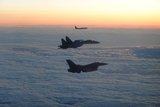MUOS radio terminal support facility opens
A new radio terminal development and certification facility has been opened by Lockheed Martin to support the US military in maximising utilisation of the Mobile User Objective System (MUOS) communications satellite network.
The US Navy’s MUOS network is expected to achieve global communications coverage in 2015, when it will significantly improve secure mobile, tactical communications for warfighters on the move. Once fully operational, MUOS will connect secure terminal users through Internet Protocol-based technology, allowing them to transmit and receive clear voice calls and data from almost anywhere in the world.
Lockheed Martin’s new Test Radio Access Facility (TRAF) in Sunnyvale, California, will assist industry in testing, developing and certifying MUOS radio terminals and government applications more quickly.
More than 55,000 currently fielded terminals can be upgraded to the MUOS Wideband Code Division Multiple Access waveform. TRAF will allow developers to test and validate new software, hardware and applications, under a variety of operational environments, using TRAF’s ground segment testbed and satellite simulator. Private ‘suites’ will allow companies to maintain proprietary and secure areas, as well as facilitate joint development, including interoperating in over the air testing. Developers also can test terminals and applications on the same equipment expected to be used for final certification.
Glenn Ladue, MUOS TRAF manager, said: ‘Lockheed Martin’s goal with the TRAF is to help terminal developers and application integrators get MUOS’ capabilities deployed to the warfighter as quickly as possible. Providing a high fidelity, end-to-end test environment during development will dramatically shorten the time it takes to get from a good idea to operational utility.’
More from Digital Battlespace
-
![Babcock nears first customer for Nomad AI translation tool]()
Babcock nears first customer for Nomad AI translation tool
Nomad can provide militaries with real-time intelligence, saving critical time on the battlefield.
-
![AUSA 2025: Israel’s Asio Technologies to supply hundreds of improved Taurus tactical systems]()
AUSA 2025: Israel’s Asio Technologies to supply hundreds of improved Taurus tactical systems
Taurus operates alongside the Israel Defense Forces’ Orion system which supports mission management across tens of thousands of manoeuvring forces, from squad leaders to battalion commanders.
-
![AUSA 2025: Kopin pushes micro-LED plans as China moves faster]()
AUSA 2025: Kopin pushes micro-LED plans as China moves faster
The plan for the new displays follows fresh investment in Kopin’s European facilities by Theon and an order for head-up displays in fielded aircraft, with funding from the US Department of Defense.
-
![AUSA 2025: Persistent Systems to complete its largest order by year’s end]()
AUSA 2025: Persistent Systems to complete its largest order by year’s end
Persistent Systems received its largest ever single order for its MPU5 devices and other systems earlier this month and has already delivered the 50 units to the US Army’s 4th Infantry Division.
-
![Aselsan brings in dozens of companies and systems under the Steel Dome umbrella]()
Aselsan brings in dozens of companies and systems under the Steel Dome umbrella
Turkey has joined the family of countries attempting to establish a multilayered air defence system with government approval in August 2024 for the effort landed by Aselsan. Dubbed Steel Dome, the programme joins Israel’s Iron Dome, the US Golden Dome, India’s Mission Sudarshan Chakra and South Korea’s low-altitude missile defence system.
-
![DSEI 2025: MARSS unveils new agnostic multidomain C4 system]()
DSEI 2025: MARSS unveils new agnostic multidomain C4 system
MARSS’ NiDAR system has been deployed using sensors from static platforms to provide detection and protection for static sights, such as critical infrastructure, ports and military bases.

























